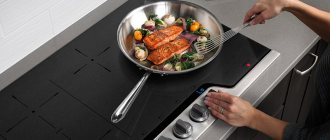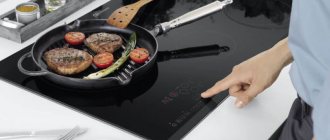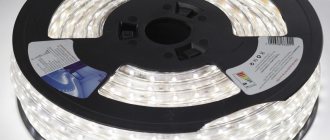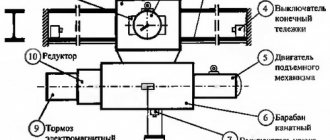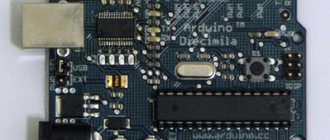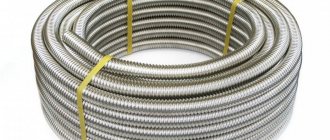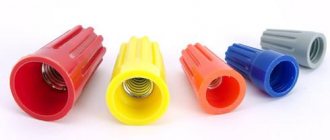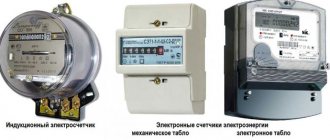To assess the effectiveness and usefulness of a particular hob, you first need to understand the principles of its operation.
And they differ significantly from each other. Most simple electrical panels have a resistance inside the housing in the form of a spiral heating element, halogen or tape laid out in a circle.
When current passes through them, the spiral heats up, transferring heat to the outer surface of the plate.
Only after this does the cookware placed on it begin to heat up.
The operating principle of an induction cooker is often called cold. This hob has a built-in induction coil, which, when current passes through it, does not release thermal energy, but creates an electric magnetic field.
From it, Foucault eddy currents begin to flow in the bottom of a special dish made of ferromagnetic material. They heat the dishes themselves.
This way, the surface of the stove does not become hot, and food is cooked by directly heating the pots and pans.
This is the most important feature of induction panels - direct heating of the container (not food, as in microwaves) in which food is cooked, without any intermediaries.
However, in addition to this, there are a number of other indicators, which we will consider in more detail, so that you can make an informed choice and buy the most suitable hob for your kitchen.
Energy Saving
A sore point for a thrifty housewife: which stove consumes more and which consumes less?
With the constant increase in prices for electric energy, one of them will help you save several tens or even hundreds of kilowatts per month.
The power of one burner in both models depends on its size and ranges from 1 to 2.5 kW.
There is, of course, a so-called booster - a quick warm-up button on induction panels.
On it, the power of individual circles can simultaneously increase up to 3.5 kW. A liter of water boils in just one or two minutes.
But we will not take it into account, because the point here is not in the power of the burner, but in the principle of heat transfer discussed above.
An induction panel does not need to waste time heating its surface and then transferring the heat to the cookware. She immediately heats the dishes.
By eliminating this intermediate process when cooking, you will save energy (due to less time).
How much can you really save on this per month? It all depends on the size of your family and the time you spend in the kitchen.
On average, it is estimated that an induction cooker saves up to 20-30% kilowatts compared to a conventional electric Hi-Light. Not to mention the old ones, with cast iron pancakes.
Roughly speaking, if your cooking used to take 100 kW, then with induction, the meter will turn up 70-80 kW. All energy will be spent only on heating the dishes, and not the air around. Judging by the reviews, some are able to save significantly more.
In a conventional one, a lot of excess heat is spent on useless heating of the environment. Especially if the size of the circle exceeds the diameter of the vessel.
Big savings are noticeable when preparing some quick dishes. For the same heating of a kettle or scrambled eggs on an induction stove, you will spend almost half as much time and kilowatts.
Such savings are also ensured by the start-stop operating mode. Cheap stoves cannot constantly maintain high power in frying mode. They go to maximum and turn off so that the food does not burn.
Then they start again and so on. The cycle will repeat until you remove the plug from the socket.
The same applies to working at low power. In fact, when you change the power, the frequency at which the stove turns on changes. This is typical for models with step adjustment (1-2-3, etc.).
In more premium segments (from $500 and above), where the power changes smoothly when you run your finger along the line, housewives complain much less about problems with constant switching on and off.
Functionality
The latest generation of induction cookers are more reminiscent of glowing screens with artificial intelligence, which are often found in science fiction films about spaceships. In addition to traditional heating functions, manufacturers build in a lot of additional service modes that turn culinary experiments into a sequence of simple commands, accessible even to a beginner.
Control
This is perhaps the most important part of the hob, with which manufacturers are constantly experimenting. The simplest models have touch buttons indicating cooking modes. More advanced ones offer their owners control of horizontal or circular sliders that respond to finger touches.
But kitchen technology leaders are building in full-fledged screens that resemble electronic notebooks. Such miniature databases will contain not only a list of possible modes, but also step-by-step recommendations for preparing a variety of dishes.
The most “advanced” stoves have built-in recipe books
And, of course, a good induction cooker, like all kitchen appliances, can be integrated into a smart home system. Not only will it independently turn on the hood and regulate its power, but it will be able to be controlled remotely from a smartphone.
Intense heating
The structure of the arrangement of heating elements in an induction cooker differs from the design of an electric surface. If the last heating point is located directly under the designated perimeters in the form of pictograms, then the induction coils are smaller and larger in number. Thus, they cover about 90% of the panel, which allows you to connect additional heating according to a given mode. This function is most often called Booster, but some manufacturers use the name Power or a mixed version - PowerBoost.
Connecting an additional source can increase the heating power from 2.5 to 4 W. However, the function has a time limit of about 10 minutes.
Changing the heating zone
Also, the induction model is capable of independently determining the required heating zone for a standard frying pan or saucepan, turning on the wave coils only in the place where the dishes are placed. Recent developments are no longer limited by the rigid contour of an invisible “burner”. An “x” pictogram may be applied to the surface, indicating the heating center or a fairly large rectangle that is not tied to the size of the bottom. The farther the pan is moved from the center point, the weaker the heat will be. Thus, the PowerSlide or PowerMove mode allows you to “turn up or turn down the heat” simply by moving the pan across the stove.
The center of the heating zone is marked with a cross
The large coverage area for heating the induction surface will be useful when using non-standard or large cookware. This could be a large “boiling” for jellied meat, a square grill pan or an oval duckling pan. To uniformly heat a large container, just turn on the Bridge function. The name suggests that a kind of bridge will be laid between the two cooking zones, which will ensure simultaneous operation and general heating.
Determining the presence of dishes
Sensors on the surface of the induction panel can read the presence of cookware placed on it. Therefore, the danger of spontaneous switching on of an empty stove is eliminated. However, you should be careful and not leave a plate or large cup that is not equipped with a special magnetic bottom on a deceptively cold surface. Heaters will only ignore a small object (a spoon or fork).
The usefulness of the mode lies in the fact that when you clean a pot or pan with a finished dish, the surface will turn off on its own.
Interrupting operation and locking the panel
There are often times when it is necessary to stop the cooking process for a while in order to return to it later. For such cases, there are two basic options.
- If a short shutdown (up to 30 seconds) is necessary to remove scattered or spilled ingredients from the surface, the Cleaning pause function is used. After half a minute, the induction hob will continue cooking automatically.
- If a situation arises where you need to leave the kitchen for a longer time, the manufacturer suggests turning on the interruption for an indefinite period of time. It may be called Stop&Go or Re-Start. When activated, the program will remember the time at which it stopped. After returning, just click on the same mode and cooking will continue.
As for the “child lock” function, it will work for an unlimited amount of time until an adult removes the lock.
Cooking control
One of the most important functions that all cooks are familiar with is cooking control. For example, when cooking soups, there is a practice of gradually adding ingredients. It is often necessary to wait until the liquid boils, after which it is necessary to “turn down the fire.” Some induction panels have learned to independently recognize the boiling process and reduce the heating energy in order to continue cooking without human intervention. This will prevent cases of liquid overflowing onto the stove or strong evaporation.
You can set the alarm to notify you when the boiling point is reached. Since induction waves do not heat the bottom of the pan, but only its contents, when boiling bubbles appear in the water, a vibration effect will occur. The stove counts it and beeps.
The “keep warm” mode is similar to the ability of multicookers to “simmer” a dish for some time after cooking is completed. This skill will be useful if not all family members have returned home or are not yet ready for a meal.
Touch panels of premium induction cookers can contain not only individual cooking modes, but also provide step-by-step recommendations. Sometimes the package includes an electronic probe for measuring temperature while cooking steaks or fish. In this case, the electronic notebook will provide instructions on the desired roasting temperature.
Cooking dinner using a timer in new hobs has been supplemented with an intelligent calculation function. The stove may turn off a little earlier than the set cooking time so that the dish can “cook” using the residual heat. This ability further increases the energy efficiency of an induction cooker, which, even during normal cooking, is less energy-consuming compared to its “electric” sister. The speed is achieved due to direct heating of the contents of the pot or pan. In this case, heat is not consumed on the surface and bottom of the cookware.
Heating rate
Meticulous users, to find out which stove heats faster, carried out real measurements. To do this, we took two pans of the same type with the same temperature of water and body walls.
Next, we needed to find out which stove would boil water faster? Induction has always coped with this task several times faster than simple electric.
This is again explained by the exclusion of an extra intermediary from the process. Everything is elementary.
Fewer elements to transfer heat, faster heating. Is this always convenient? It turns out not.
For example, when heating something liquid with solid pieces, the liquid will boil quickly, but these same pieces will not warm up immediately. With such food, it is better to initially set the power a little lower.
By the way, manufacturers of cheap induction cookers often deceive their customers. A circle of a burner of the same size is drawn on the surface, but in fact, inside there is an inductor coil of a much smaller diameter.
Hence the lower heating rate and greater overheating of the central zone. As a result, all the food that gets into the center of the frying pan will burn, and vice versa at the edges.
How can you find out at home without disassembling the panel? Elementary. Place a frying pan much larger than the circle drawn on the stove, pour water into it and turn it on to maximum.
After a minute, you will see the actual diameter of the heating zone from the bubbles formed.
Every housewife can find out in this simple way how good and high-quality the induction hob was sold to her. Remember that a small inductor on a large pan gradually leads to uneven heating and deformation of the bottom.
Nuances of the right choice
In order for you to be as satisfied as possible with your purchase and not regret it later, you need to understand the nuances of choosing slabs. We already wrote above that there are many varieties of them. Not all of them are suitable for home use. Moreover, if you want to feel the efficiency of such panels, you need to understand all their details.
When choosing an induction hob, be sure to check which burners are on it. The fact is that induction panels are a type of electric, but with their own special operating principle. Externally, all types of electrical panels - induction, rapid, spiral, strip, halogen - are similar, but each has its own technology. It's easy to confuse them.
On some models you can only cook one dish. They do not have the ability to cook several at once. Don't forget to clarify this nuance. If you are buying a stove for your home, do not choose one that is too expensive. They tend to have very different features that you won't need. Such panels are designed for use in restaurants and cafes. Induction hobs offer the widest variety on the market. In addition to different colors, you can also choose a shape: square, round, arched, hexagonal or triangular. And some studios create panels according to individual drawings. If you do not plan to change the dishes to ones specifically designed for this type of panel, then buy a special adapter disk.
There are already many different brands on the market that offer induction. But choose panels only from manufacturers you trust. Don't be fooled by the low price of an unknown company. It’s better to pay more money than to throw away the purchase a month later. A small family should take a closer look at small models with two heating zones. But if you have a lot to cook, then it is better to choose those that have many burners. Remember that some models have a function to increase the heating zone. Thanks to it, you can place large dishes on the stove.
Be sure to measure the parameters of the place where you plan to place the purchase. This is necessary so that there are no gaps between the panel and other surfaces. They are quite large, so they need quite a lot of space. If it is just a hob, then it cannot be placed above the oven.
See if the selected model has a residual heat indicator. It is convenient because you will know exactly how long to wait until the cookware is completely heated.
Check the quality of the panel. Tap it. It should be dense and durable. Study it carefully. If there are scratches on it even before purchasing, it is better to leave it in the store. Below we will introduce you to the pros and cons of an induction cooker.
Inertia
What is this indicator and what does it mean? Inertia is the time of heat retention after a power outage. Roughly speaking, how long does it take for the panel to cool down?
In some cases, food requires a certain time during the cooking process to “reach” the desired consistency - the simmering effect.
And here this same inertia will come in handy. If you reduce the temperature on an electric stove or turn it off completely, it will not cool down immediately.
In this regard, induction is closer to gas. I turned it off and the temperature immediately dropped. This is especially useful when something boils or “runs away” from the pan, and you need to instantly reduce the temperature. Here, excessive inertia seems to be a problem.
To create the effect of inertia, the induction cooker has a pulsed simmer mode. That is, on “low heat” the low boiling power is regulated something like this: it heats for 3 seconds, not for 3 seconds.
At this time, the water will either boil or cool, which is not very convenient and will give an unpredictable cooking result. The problem is partly solved by using dishes with a thick multi-layer bottom.
Based on the above, it is impossible to give an unambiguous answer to the question of which type of slab is better and which is worse in terms of inertia. Each housewife decides for herself.
What is induction
The principle of electromagnetic induction is actively used in the production of household appliances. What is induction and how does it work? The electromagnetic field of the hob actively affects the metal surface of special cookware. The innovation of this technology lies in the fact that during the cooking process, the bottom of the frying pan or pan is heated, and the remaining elements of the kitchen utensils do not interact with the electromagnetic field.
In 1987, AEG introduced the world's first cooker operating on the principle of electromagnetic induction. Instead of traditional heating elements, a special coil was used, which ensured the creation of an electric field. It easily penetrates through the glass-ceramic surface, forming a current near the bottom of the dish.
There is a special disk at the bottom of frying pans and saucepans. This design guarantees circular movement of current. This is how food is thermally processed. To simplify, the main principle of this technology is heating not the burners, but the dishes. Electromagnetic induction was discovered by M. Faraday in the middle of the 19th century.
Safety
The electric hob heats up to 500 degrees during operation!
Of course, no one would even think of touching the red circle with their hands. However, after turning off, when the circle goes out, do not forget about the above-mentioned inertia.
This is where you can get a painful burn. There's no mention of children. These curious creatures are simply attracted to the “bright red sun” on a black surface.
And pets, walking on the stove with their paws, can easily turn it on in your absence (if you forgot to turn on the lock when leaving).
Therefore, the safety of electrical panels, despite the absence of open flames, is at a very low level.
In induction cookers, even when the power is turned on and the pan is removed from the surface, the automation immediately generates an error and turns off the stove after a while without your participation.
The surface remains cold even during cooking.
The only thing you can get burned on here is the dishes.
Advantages of the stove adapter
When choosing the optimal model of an induction hob, you often come across an accessory such as a stove adapter. This device will be extremely useful when using any type of cookware made from various materials that were not originally intended for this type of stove.
The advantage of the accessory is that such a solution for an induction hob will allow you to save on the purchase of a set of special cookware or make it possible to use familiar ceramic or glass kitchen utensils for cooking. In this case, the efficiency will be the same 90%, and there is also no heat loss, and, consequently, excessive energy consumption.
The average diameter of adapters, which are most often found in stores, is 22–24 cm, but it is also possible to install smaller dishes, for example a coffee pot or a small container for melting cheese and chocolate.
For many users, purchasing an adapter will be an excellent alternative to changing kitchen utensils.
Cookware for induction cooker
On an electric hob you can cook food in any container. Place whatever you want and heat it up.
But with an induction cooker you will have to part with most pans with a thin coating. In frying pans and pots with little metal, induction does not work very well.
The wall thickness should be at least 2mm, and the minimum bottom diameter should be 8-12cm. You can’t make delicious coffee in a small Turkish coffee pot.
Therefore, special utensils made of a ferromagnetic alloy are usually used for such stoves. When buying it, pay attention to the icon.
If you don't have such utensils, adapters are available. Place this adapter on an induction hob, and place your favorite frying pan on it.
Is it convenient or not? Not really. It turns out that you return to that same extra intermediary, which means you lose most of the advantages discussed earlier.
At the same time, surprisingly, in old enamel saucepans and ladles, and even in grandma’s cast-iron frying pan, it is quite possible to cook food.
In general, cookware that is highly magnetic is suitable for induction cooking. First of all, this concerns the bottom. It is old cookware with a massive bottom that works most effectively with induction cookers.
If you want to make delicious pancakes, take a cast iron pan with a thick bottom. A thin one, even with a special induction symbol, will not work. The pancakes will either burn or not cook through.
Quality cast iron cookware can be found at Staub and Le Creuset.
You may have a kettle with non-magnetic stainless steel walls, but with a steel bottom. So, it will also heat up perfectly on such a stove.
The induction panel simply “will not see” all other non-magnetic cookware, including aluminum cookware.
By the way, cheap stoves can “lose” seemingly correct pans over time. At first they work normally for several months, and then bam, and they stop seeing and reacting to it.
Dishes with a crooked bottom are also difficult to recognize by the panel.
If you had said to your friends a couple of decades ago that I couldn’t cook dinner because my stove “doesn’t see” the pan, you would have been laughed at. And now this expression has become firmly established in the everyday life of advanced housewives.
Therefore, after purchasing an induction cooker, no matter how large and varied your set of cookware is, sooner or later you will have to go to the store and buy a lot of new things. And these are extra expenses and quite considerable ones.
But even with special dishes, not everything is so rosy. People who cook professionally and a lot clearly say that with induction all cookware spoils and becomes unusable faster.
First of all, this applies to cheap copies, when you leave them empty for a long time on the stove. The red circle is not visible. After several such overheats, low-quality Teflon begins to swell with bubbles and peel off.
Therefore, buy pots and pans with thick walls and bottoms.
There are many myths about the different taste of products cooked on induction and electric stoves. Think about how the heat source can affect the taste?
When cooking food on gas, heating element or induction, in all cases heat will be transferred through the cookware. A difference in taste sensations is only possible if a different container is used in all cases.
Using the same cast iron frying pan, you will not notice any change in the taste of the scrambled eggs. But with microwaves it’s a completely different story.
The only correct note from housewives is that you need to get used to the induction cooker. The cooking process here is slightly different.
Not everyone likes it. This primarily applies to inexpensive models with stepwise power control.
You can’t put out pilaf and other dishes properly, because it burns on the bottom. I put on the water, just started cutting potatoes and carrots, and the water was already boiling. That is, for soups you need to prepare everything in advance. Pies sometimes turn out ready on the outside, but raw on the inside. Since there is no normal “slow” fire.
And some manufacturers implement a safe shutdown function at the software level. This is when the stove itself can turn off after 3-4 hours. She doesn’t care at all that your dish has not yet reached its standard.
And so in many other things. Those who don’t want to retrain, return to the good old electric stoves, or buy combined options - two induction burners, two HiLight.
Or they use the so-called “Domino” models.
From them you can generally assemble a multifunctional work area for all occasions.
What are the differences from other plates?
Induction cookers compare favorably with other types of stoves (gas and electric).
A number of points are worth highlighting:
- The efficiency of induction furnaces reaches 90%. For comparison, in gas stoves this figure is only 30-60%, and in electric stoves - no more than 70%;
- High heating rate (devices with heating elements or gas burners cannot boast of this feature);
- Efficiency. After removing the dishes, you do not need to turn off the work area manually - this happens automatically. In electric or gas stoves, the burner continues to work, which leads to excessive consumption of gas and electricity. In the summer, this is especially important, because there is additional heating of the air, which complicates the process of air conditioning (cooling) the room;
- Precise temperature control. On stoves with heating elements or those running on gas, temperature control occurs “by eye”. In the case of induction cookers, you can maintain the same setting throughout the entire cooking time;
- Safety. If a person accidentally mixes up the cookware and places a product with a non-magnetic bottom, the burner will not work. To activate the burner, the cookware must cover its area as much as possible, 50% or more;
- Many additional functions that classic gas or electric stoves cannot boast of.
Multifunctionality
Expensive induction models, in addition to the standard functions of heating dishes, have a number of unique features that you will not find in electric stoves:
- information display
A monitor can be built right into the surface of the stove, through which useful and useless information will be displayed regarding cooking and more.
- connection to the smart home system
And this is the ability to independently turn on the hood at the right time, remote control and monitoring via a smartphone and communication with other smart gadgets.
- food recognition
If you accidentally left a wooden cutting board, telephone or other item on the panel other than a ferromagnetic alloy cookware, the stove will understand this and simply will not turn on.
- ultra-fast heating – booster
You press a special button, the power of the mug immediately increases significantly, and the water boils much faster than under normal cooking conditions.
Problems
Cookers operating on the induction heating principle have not been in demand for a long period of time. There are two reasons - the high cost, as well as rumors that they negatively affect the human body.
Harm to the human body
There is an opinion that electromagnetic heating technology has a negative impact on human health. Many fear that built-in or tabletop stoves create a field that has a detrimental effect on the condition of internal organs. To bust these myths, a study was conducted. Induction surfaces have been compared to conventional hair dryers.
The results of the study shocked the public. The electromagnetic field of a conventional hair dryer is 2000 microtesla, and that of a hob is 22. A hundredfold difference. Such a weak field does not affect the human body in any way.
Turning on the stove from any metal object
Users who have not properly studied how an induction cooker looks and works believe that it turns on even if there is an ordinary pot or frying pan on the burner. This is a common misconception. The stove starts working if there is an appropriate cookware on the burner. Its bottom has the necessary attraction, unlike ordinary kitchen utensils.
There are special sensors inside the plate that are adjusted to the minimum diameter. If the diameter of the bottom of the dish is less than 8 centimeters, then the pan or pan will not heat up.
Heating metal objects under the stove
Another common myth that scares potential buyers. Theoretically, the stove can help heat the metal products located underneath it. However, modern models of household appliances are equipped with a magnetic heat sink, which is located at the bottom. This device blocks the penetration of the electromagnetic field through the lower part of the equipment body.
Today, stores offer a wide range of combined surfaces with cabinets that are built into furniture above dishwashers and other appliances.
Care and maintenance
When milk and other liquids escape, it ends up with burnt spots and other unfortunate consequences on your electric cooking surface.
When you try to clean it all perfectly, scratches appear. Or whatever you are trying to wipe it off with starts to stick.
For old stubborn stains you will have to buy special scrapers.
As a result, the former beauty disappears, and the surface itself gradually becomes unusable. Nothing burns or sticks on an induction hob.
This is equivalent to spilling milk on the table. Take a cloth, wipe it and continue using it.
Cleaning the induction cooker takes just seconds. Such a surface is almost never dirty. You will also forget what the black, burnt bottom of the dishes is.
All this saves effort, time and money on detergents.
Separately, it is worth mentioning the color. For some reason, most people prefer black slabs. They seem to look nicer and fit better into the kitchen design.
However, with this color, fingerprints, grease stains and abrasions will be visible from any corner of the room.
But practically nothing is visible on the white panels.
Yes, some brands may turn yellow over time and spoil their appearance, but this applies to cheap models. Therefore, initially choose high-quality stoves from reputable manufacturers (Gorenje, Bosch, Zanussi, Electrolux).
What to look for when purchasing
It’s easiest to decide on the type of stove, but understanding the modifications and additional options is not always easy. What should you pay attention to when choosing a good induction hob?
- The number of burners - it can be different, it is worth determining which will be optimal.
- The number of cooking modes can vary over a wide range, the average value is 15.
- Size. For many, the dimensions of a household appliance play an important role; if there is not a lot of space in the kitchen, you can take a closer look at portable or built-in 3-burner models, they are quite stylish and will allow you to place other kitchen items nearby.
- The Boost intensive heating function is useful for those who live in a strict rhythm. It will allow you to quickly heat a kettle, water for soup or pasta.
- The Stop&Go function allows you to pause the cooking process for a short period of time.
- Maximum cooking time - often limited to 3 hours, which goes against some recipes. Naturally, the cycle can be extended and the device will continue to work.
- Switching modes – not every induction surface will allow you to set different modes on different burners; most often, this option is not available in budget models.
Understanding what an induction cooker is and what options it can have, it is quite easy to make the right choice when looking for a new cooker. By comparing induction and traditional electric stoves, you can identify the pros and cons of both options. In general, induction hobs have an intuitive interface, a number of safety systems and convenient cooking modes.
Ergonomics
Most housewives dream of a stylish kitchen with one line so that all the cabinets hang evenly.
The induction hob is perfect for this. An electric stove has strict limitations in this regard.
The minimum height for installing cabinets or hoods above it is 550mm and above (for gas - 650mm).
Restrictions are related to fire safety.
Theoretically, the façade could char or even catch fire. Induction doesn't have this problem.
And it also saves space. If you have a small kitchen and lack of work area, you can remove the pan from the stove and immediately put a cutting board in its place without interrupting cooking.
It turns out that the surface of your stove can perform double duty. There is no need to allocate extra meters for this and go around the “fireball” when cooking.
Technical features
If you look at the diagram of a regular induction electric stove, it will contain 5 elements:
- glass ceramic surface;
- insulation;
- a coil that induces eddy currents;
- frequency converter;
- Control block.
Induction panels are produced in standard or non-standard dimensions, thanks to which they are easily built into kitchen furniture, and the dimensions do not always affect the number of options and technical characteristics.
Metal frames can run along the contour of the built-in slabs - they are created for additional rigidity and to protect the edges from chipping.
As a rule, the stove is a smooth glass-ceramic surface, under which all the components are located. The control panel is most often located in the front part, but there are modifications where each burner is equipped with an individual set of touch buttons.
The design of induction electric cookers will impress even discerning users: universal colors, laconic control zone, informative markings, in a word - Hi-Tech in its full splendor.
Extraneous sounds and noise
A conventional electrical panel is absolutely silent in operation. But with induction there are often problems.
For example, crackling or humming when using low-quality cookware. This is caused by the difference in expansion temperature of dissimilar materials. Cookware with a ferromagnetic bottom cracks because the density of the steel body and the bottom are different.
Place a homogeneous enamel saucepan on the surface and you will not hear anything.
So don't listen to experts who say that induction makes a rattling noise. It comes not from the stove, but from the dishes!
In addition to noise, such dishes create vibration. Just put your hand on the tabletop next to the panel and you will clearly feel it.
If the panel is initially installed clumsily, such vibration may even cause empty pans to run away from the stove.
However, even if your cookware is of high quality and there is no cracking noise observed during heating, there is no escape from the noise of the coolers cooling the electromagnetic coils in booster mode. The sound from them is like a fan on a computer system unit.
But if the hood is running while cooking, you don’t really notice it.
How to use?
There are no special rules for induction devices: their controls are simple, but the instructions for your specific model will help you understand it in more detail.
However, there is also general information that everyone should know. For example, differences in the requirements for dishes:
- Not all metal utensils are suitable for cooking. For example, the stove will not work with budget aluminum saucepans and cauldrons.
- Suitable utensils include cast iron, steel, enameled, copper.
- You can make sure that the cookware will fit exactly by carefully examining the packaging: look for the spiral icon or the inscription Induction.
- An equally important parameter is a flat bottom! For a number of reasons there should be no protrusions or indentations - as flat as possible is best.
- The bottom of small containers should not be less than 12-14 cm. The Turks are too small, the stove ladles simply do not heat up.
- The distance between the edges of the burners and the bottom of the pan should be approximately the same. In this case, it is better to take dishes smaller than a larger mug, and place them in the center.
Advice! A convenient way to check dishes is with a refrigerator magnet. If it sticks to the bottom, then the pan is suitable.
Helpful Tips:
- In various sources you can find information that the stove burners do not heat up - on the one hand, this is true, heating occurs immediately on the cookware. On the other hand, heat from the bottom is transferred to the surface, so you should not touch the stove after turning it off.
- Most induction cookers are equipped with a protection system: they automatically turn off after 180 minutes of continuous operation, and the power is blocked if various liquids enter. Please consider this before purchasing.
- Additional functions, such as Booster (transferring energy to an adjacent burner) or maintaining heat, greatly simplify life.
Harmful radiation
Many housewives are afraid of the harmful electromagnetic radiation that all induction cookers have.
There is definitely radiation. However, it does not have a harmful effect on you, even if you put your head to the stove itself. You are not a cyborg with an iron brain to create eddy currents.
With normal use of the panel, when you cook food at a distance of 20-30cm from its surface, no negative effects occur either.
At a distance of up to 10 cm from the stove, the intensity of the electromagnetic field is about 140 Volts/meter. At a distance of up to 0.5 m it drops to 15 V/m. Here are the acceptable values for this indicator:
Some people mistakenly compare induction cookers to a microwave. But there are completely different frequencies. The microwave contains microwaves (ultra high frequencies), which cause resonance of water molecules. Their friction causes the water to boil. And our body, including the brain, consists of water.
However, we still use microwave ovens. Induction cookers are much safer in this regard.
Measurements were even taken and it turned out that the electric magnetic field near the stove is tens of times less than near an electric hair dryer, which you regularly dry your hair with and bring directly to your head.
However, sick people who wear special pacemakers need to be very careful.
The electromagnetic field of the stove, under certain conditions, is quite capable of damaging such a device. Therefore, in order not to take risks, the instructions usually state that people with similar diseases should be at least 30 cm away from the surface of the panel.
But this is standard reinsurance for manufacturers of such equipment. Some instructions for microwave ovens in the USA even indicate that wet cats should not be dried in them.
Also, do not forget about bank cards and magnetic passes. They should not be brought too close to the stove during cooking, as they may become demagnetized.
What the market offers, main manufacturers
Below is a brief overview of the most popular manufacturers and some of their products today.
Skvara
This developer markets professional induction cookers that can be used in cafes and restaurants.
Their advantages include greater efficiency, the fastest heating of dishes, the presence of a timer and temperature controller, as well as ease of maintenance.
Here are some manufacturer models:
- 2-burner induction cooker Skvara Sif 2.4 4 kW.
- Stove FROSTY BT-E35.
- Professional oven Skvara Sif 4.8.
Electrolux
The most popular models of induction furnaces from Electrolux include:
- Electrolux EKI 54550 - stove with heat indicator, glass-ceramic surface. The number of burners is 4. There is an electric oven with a volume of 60 liters and a power of 3.7 kW. Among the additional functions, it is worth highlighting convection and grill. The width of the slab is 0.5 m.
- Electrolux EKI 6451 is an equally popular model, which is similar in characteristics to the stove described above. The difference lies in the width (0.6 m), volume and power of the electric oven (72 l and 3.6 kW, respectively).
Gorenje
The following models are worth highlighting from this manufacturer:
- Gorenje EI 637E21 — induction hob with heat indicator and glass-ceramic top. There are four work areas for cooking. There is an electric oven with a capacity of 66 liters. Among the additional functions, it is worth highlighting the grill and convection.
- Gorenje ICG 3400 is an induction cooker with two heating zones. The surface is made of plastic. Product width 0.6 m.
Hansa
This manufacturer offers a wide selection of cookers, including induction-type products. One option is the Hansa FCIW58277 stove with heat indicator.
The surface is made of glass ceramics. The number of hobs is 4. There is an electric oven with a capacity of 65 liters. The width of the product is 0.5 m. Additional functions include convection.
Saturn
The brand's products have an affordable price and relatively high quality. Among the manufacturer's induction cookers, it is worth highlighting the Saturn ST-EC0187.
There is only one induction burner here. The surface is made of glass ceramics. No additional functions are provided.
Ease of use
When using an electric hob, you will need a huge amount of patience. This is exactly what will help you prepare food without nerves and come to terms with slow heating or cooling of dishes . If the electric stove burner heats up instantly, the cookware gradually increases and decreases temperature. To reduce the “fire”, you will need to go through the stages of a gradual decrease in temperature.
The induction surface is much more convenient in this regard. It instantly heats the dishes and quickly resets the temperature .
For maintenance, both models require the use of a separate sponge and detergents designed for cleaning glass-ceramic surfaces.
Electric hob: all the pros and cons
The advantages of this variety include the following indicators:
- slab models are made in a variety of colors, which allows you to create a harmonious interior design;
- heating occurs relatively quickly and smoothly;
- the air temperature in the room is maintained due to the residual thermal effect;
- no pan racks required;
- Convenient and easy cleaning of the stove.
Negative sides:
- has no surface deflection; due to its absence, spilled liquids spread everywhere;
- limited load weight;
- does not tolerate the ingress of substances that contain sugar;
- requires the use of cookware with a suitable bottom diameter and material of manufacture.
Which is better: induction or electric stove, pros and cons of products
To understand the question of how an induction cooker differs from an electric one, you must begin by studying the operating principle of each device. The electric device immediately heats the burner to the required temperature. The heat is then transferred to the utensils placed in the work area. Heat is generated as a result of the passage of electric current through a conductor.
The electric stove first heats itself and only then transfers the heat to the cookware
The latter is a resistive heating element, which is characterized by a high resistivity value. The conductor is represented by a spiral, which can be located openly or hidden under the burner.
Among the distinctive advantages of an electric stove are the following:
- silent operation of the device;
- the ability to use any utensils;
- reasonable cost;
- the burners heat up for a long time and cool down slowly, so you can leave the finished dish on the surface to “cook”;
- a wide range of color and design variations, which allows you to choose a model to suit any interior style of the room;
- the surface does not require special care and can be easily and simply cleaned using ordinary detergent.
The disadvantages of the stove include:
- significant energy costs;
- the panel has a limit on the weight it can withstand;
- a high degree of fire hazard increases the likelihood of traumatic burns.
High power consumption is one of the disadvantages of the electrical panel
Choosing hobs: manufacturer ratings
When choosing a hob, it is very important to pay attention to the manufacturer of the equipment. All manufacturers who produce induction and electric hobs can be divided into three categories depending on the quality of the product:
- elite professional models are produced by Miele, AEG, Gaggenau, Kuppersbusch;
- mid-range products, which are characterized by an ideal price-quality ratio, belong to Bosch, Siemens, Whirlpool, Gorenje, Zanussi, Electrolux;
- Good quality budget series are offered by manufacturers Hansa, Ariston, Ardo.
The greatest demand is for mid-price hobs from global manufacturers.
Elite class models are most often purchased for cafes and restaurants. They are characterized by a maximum number of heating zones, have high power and expanded functionality. The main feature of such models is their high cost, which is not justified for using the products in modern kitchens.
Based on numerous reviews, mid-price hobs from global manufacturers are in greatest demand. This is due to the wide range of reliable products that the average family can afford. The models are distinguished by decent workmanship, an expanded range of necessary functions and programs used in everyday use, and an original design, thanks to which the products fit perfectly into the modern kitchen interior.
Models from the budget category are characterized by good quality and affordable cost. Here we mainly present products equipped with a minimum set of functions.
In pursuit of savings
When buying a hob, it is important not only to look at the cost of the model, but also to calculate how much its operation costs. From the above advantages, the conclusion suggests itself: an induction furnace uses electricity more economically, so its operation is much cheaper. But at the same time , the price of a new induction cooker is higher than an electric stove .
It is also worth considering the cost of purchasing new cookware if there is no hob suitable for the burners.
